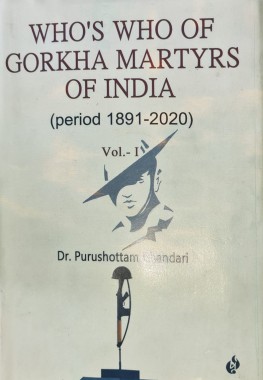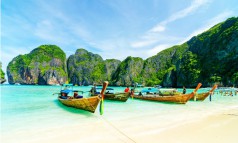




















Wednesday, Feb 03, 2021 07:30 [IST]
Last Update: Wednesday, Feb 03, 2021 01:49 [IST]
Book Review
" If a man says he is not afraid of dying, he is either lying or he is a Gorkha", said Sam 'Bahadur' Manekshaw, the first Field Marshal of India, about the bravery of the Gorkha soldiers of India.
The blood- red history of martyrdom of nine hundred seventynine Gorkha soldiers is packed in a book titled "Who's Who of Gorkha Martyrs" authored by veteran writer Dr P. Bhandari.
"Who's Who of Gorkha Martyrs" is the third historical book written by Dr Prof. Purushottam Bhandari, who teaches economics in a college of Assam. It is purely about the innumerable Gorkha martyrs of India who laid down their lives since 1891 upto 2020 fighting against British imperialism first and then in all other wars imposed upon our country since Independence, this book, said to be the first volume of this series, comprises of 255 pages in hard binding and priced at Rs. 500. Published by Purbayon Publication and dedicated to Gorkha soldiers, who, as usual, are ever ready to sacrifice their lives for the motherland, this book comprises of four chapters and a long list of bibliography.
Launched on 31st January, 2021, on Vishnu Rava Divas, another towering freedom fighter, at the prestigious Shankerdev Kalakshetra in a glittering function, the release of the book marked another mile's post in the history of Assam's Gorkha, with the organisers declaring an annual award titled " Shaheed Niranjan Singh Chetry Samman" to the families of Gorkha martyrs.
It can be said without doubt that the book compiles all the Gorkha martyrs in one book hitherto unseen and unknown in the annals of the country. Besides being a great source of general knowledge and information for all readers, the book can best be used as a resource book by all researchers in future. The hard and consistent labour put in by Dr Bhandari for the timely compilation of the book deserves kudos and thanks from all quarters. Actually the resources for Gorkha martyrs are very few and really hard to find. Even Government sources are either difficult to procure or too scanty for the purpose. It is only long and laborious trips that enabled the writer to find about the martyrs and their families. In addition to these he consulted a long list of other source books for verification, proof and references of his data.
Dr Bhandari has recorded the life-sketches, however brief, of each of the martyrs in chronological order for an easy understanding for the readers. This book will definitely clear the ideas of both the administration and the civil society of the country about the roll and participation of the Gorkhas in the attainment of independence, protection of the country and the building of nation inside the country. The Gorkha regiments of India bear a huge responsibility in guarding the country and posing a threat to foreign invaders. The long lists of martyrs and the numerous Gorkha battalions recorded in this book verify this fact. The irony is that in spite of such grand and glorious history of patriotism the Gorkhas have no place, no state, and no constitutional or statutory safeguard of their own in such a vast country. Rather they are driven out from their ordinary place of residence by majority communities in connivance with the local administration. This book is being published at a time when the Gorkha soldiers, who averted the Chinese move to annex part of Arunachal Pradesh in 1962, and who were given settlement in this virgin land, Vijoy Nagar, by the union govt itself, are being threatened with eviction from their place of residence in Arunachal Pradesh.
Now, we will go part by part of the book. In the preface of the book the author admits that though there are many books published on War History of India -- Indo-China War of 1962, Indo-Pak War of 1965, Bangladesh War of 1971, Kargil War of 1999 etc., there remain many instances of sacrifice and hundreds of martyrs to be recognised and brought to light for the knowledge and information of general readers. He appreciates "Who's Who Of Indian Martyrs" authored by Pran Nath Chopra in 2013, but points out its incompleteness in recording all the martyrs of the Indian sub-continent. He then acknowledges resources of the great books like "Srasta" magazine, , "Ragatle Lekhiyeko Itihaas" by Ganga Prasad Bhattarai, 2009, etc.
He starts by giving a glimpse of Gorkha valour by quoting Late Field Marshal Sam Manekshaw who said:"If a man says he is not afraid of dying, he is either lying or he is a Gorkha." With such bravery Indian Gorkha soldiers never retreated while protecting the frontiers of the country. In the first war with Pakistan in 1947-48, so far information of 88 Gorkha martyrs has been found besides the loss of lives of hundreds of Gorkha soldiers during the relocation and rehabilitation of the sufferers of the Partition. In the Indo-China War of 1962 three hundred 39 Gorkha soldiers were martyred as per Govt. records, but the actual figure is much higher. In the Indo-Pak War of 1965 one hundred sixty Gorkha soldiers died for the country while 71 Gorkhas laid down their lives during the 1971 Bangladesh War. In the Kargil War of 1999, 22 Gorkha soldiers were killed as reported in Dr Bhandari's book.
No doubt a soldier's life is for sacrifice for the country, but definitely not for being D-voter, losing voting right, getting de-nationalised and physically getting evicted from your hearth and home. This is what is happening with the Gorkha soldiers of the country. A delegation of ex-soldiers of Vijoynagar in Arunachal Pradesh met the Union Defence Minister on 18 December, 2020, to discuss the eviction threat from the Arunachal Yuvin Students Union. In view of such physical attacks as non-national Dr Bhandari's book may go a long way in showing to the world that the Gorkhas took no less part in the protection, integration and development of the country. Thus Bhandari's "Who's Who of Gorkha Martyrs" may turn to be an eye-opener for the Governments about the sacrifices of the Gorkhas.
The book not only contains the exploits of the bravery of Gorkha soldiers but also gives vivid descriptions with details about the war theatres and war zones of all the past wars on the borders of the country. We quote a few lines from this book: " In Indo-China war of 1962, China captured most of (the) Arunachal Pradesh . During the Sino-India war 1962, the Gorkha community of Arunachal Pradesh played a dynamic role in war. It was during the period of war, three ex-army men, namely, Nar Bahadur Lumbu, Halal Limbu, and Jiang Limbu were invited by the Government of India to join army in order to drive out Chinese forces from Arunachal soil." In this way, in this chapter we get a glimpse of the past wars and the names of Gorkha martyrs one by one in every war put separately. The hard work put in by Dr Bhandari in setting the events and the plot of his book in chronological order is undoubtedly appreciable.
In the second chapter the author describes the martyrs of the Kargil War giving a short life-sketches of each and every Gorkha martyr. He starts with the pre-independent era Gorkha hero Shaheed Niranjan Singh Chettry who was hanged by the British in Manipur along with Bir Tikendrajit for revolting against them. His loyalty to the oppressed people of Indian sub-continent can easily be gauzed in view of his shifting position from the British side to that of the Manipur forces.
Next, he recounts the brief event in which the second Gorkha martyr of the NorthEast, Deucharan Upadhyaya, laid down his life in Jorhat jail while protesting against the British in 1920. Thirdly he drew a pen-picture of the events leading to the martyrdom of Bhagat Bir Tamang who died in Darjeeling district jail in 1924.
The author describes the hair-raising event of sacrifice of two Gorkha teenage girls Savitry and Indrani who were in the Bal Sena of INA. These girls saved Netaji in Manipur when Netaji was zeroed in on by the Tanks of the British forces in 1943. The girls covered themselves by green grass and lay on the road through which the British tanks were approaching towards Netaji. As the tanks treaded on the two girls they burst into pieces leaving Netaji unharmed.
Then he discusses the life-sketches of the Gorkha martyrs of post Kagil War period. And then, in the fourth and last chapter he narrates about the Gorkha Martyrs of the "Chinese Skirmishes" of post independent era. The writer clinches his list of martyrs with sketches of Sambur Gurung , Sitaram Upadhyaya, and Biljang Gurung of Himachal Pradesh who died in action on the borders in 2020.
In all Dr Bhandari recounts about nine hundred 79 Gorkha martyrs.
Thus the book "Who's Who of Gorkha Martyrs" turns to be the first book with the records of maximum number of Gorkha martyrs for the country hitherto unrecorded in any other book.
There's lot of scope for improvement in respect of language of the book. This is in spite of his hard work and sincerity in his mission. We can only hope that his future endeavours will pay more attention to these aspects of writing. Last but not the least, this huge and highly valued work with great social and moral significance, and also a work of combined effort, has been handled single-handedly by Dr Bhandari with great art and success.
